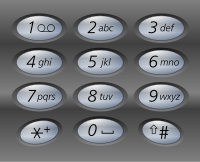RubyでBacktracking
いつものようにLeetCodeをやっていると、解法としてBacktrackingというものが出てきた。アルゴリズムの名前らしい。
Backtrackingとはなんだろうか。
問題
まず解くべき問題を説明する。
2-9の数字からなる文字列が与えられる。それぞれの数字は、以下の画像のように文字列の組み合わせを持っている。
与えられた数字をそれぞれの文字列に変換した場合にできうる文字列をすべて答えよ、という問題。

例:
Input: "23" Output: ["ad", "ae", "af", "bd", "be", "bf", "cd", "ce", "cf"].
※ 例では辞書順の出力になっているが、順序は問わない
ツリー構造
組み合わせを洗い出すと、こんなツリー構造になる。

これらすべての要素を列挙する解法の1つがBacktrackingということらしい。
Backtrackingとはなにか
概念
こちらの説明を読んでみる。
Backtracking is an algorithm for finding all solutions by exploring all potential candidates. If the solution candidate turns to be not a solution (or at least not the last one), backtracking algorithm discards it by making some changes on the previous step, i.e. backtracks and then try again.
具体的には
backtrack(combination, next_digits)という関数を考える。
combinationは現在の文字列(an ongoing letter combination)で、next_digitsは残りの数字(the next digits to check)である。

この関数は以下の処理を行う。
- If there is no more digits to check that means that the current combination is done.
- If there are still digits to check :
- Iterate over the letters mapping the next available digit.
- Append the current letter to the current combination
combination = combination + letter. - Proceed to check next digits :
backtrack(combination + letter, next_digits[1:]).
- Append the current letter to the current combination
- Iterate over the letters mapping the next available digit.
つまり、
next_digitsが空の配列ならば、そのcombinationの処理は終わりnext_digitsが空じゃなければ、- 次の数字の持つ文字列に対して繰り返し処理を行う
- 文字列を
combinationに追加するcombination = combination + letter - 次の数字に進む
backtrack(combination + letter, next_digits[1..-1]
- 文字列を
- 次の数字の持つ文字列に対して繰り返し処理を行う
Rubyで書いてみる
# @param {String} digits # @return {String[]} def letter_combinations(digits) return [] if digits.empty? @result = [] @digit_to_letters = { '2' => %w[a b c], '3' => %w[d e f], '4' => %w[g h i], '5' => %w[j k l], '6' => %w[m n o], '7' => %w[p q r s], '8' => %w[t u v], '9' => %w[w x y z], } backtrack('', digits) @result end private def backtrack(combination, next_digits) if next_digits.empty? @result << combination return else @digit_to_letters[next_digits[0]].each do |letter| backtrack(combination + letter, next_digits[1..-1]) end end end
コメントをつけるとこうなる。
# @param {String} digits # @return {String[]} def letter_combinations(digits) return [] if digits.empty? @result = [] @digit_to_letters = { '2' => %w[a b c], '3' => %w[d e f], '4' => %w[g h i], '5' => %w[j k l], '6' => %w[m n o], '7' => %w[p q r s], '8' => %w[t u v], '9' => %w[w x y z], } backtrack('', digits) @result end private def backtrack(combination, next_digits) # next_digitsが空の配列ならば、 if next_digits.empty? # もう子要素はないので、現時点での文字列を追加して処理を終える @result << combination return # next_digitsが空じゃなければ、 else # 次の数字が持つ文字列セットの要素1つずつに対して @digit_to_letters[next_digits[0]].each do |letter| # backtrack関数を呼び出す backtrack(combination + letter, next_digits[1..-1]) end end end
こういう再帰系の処理は慣れが必要な感がある。精進あるのみ。